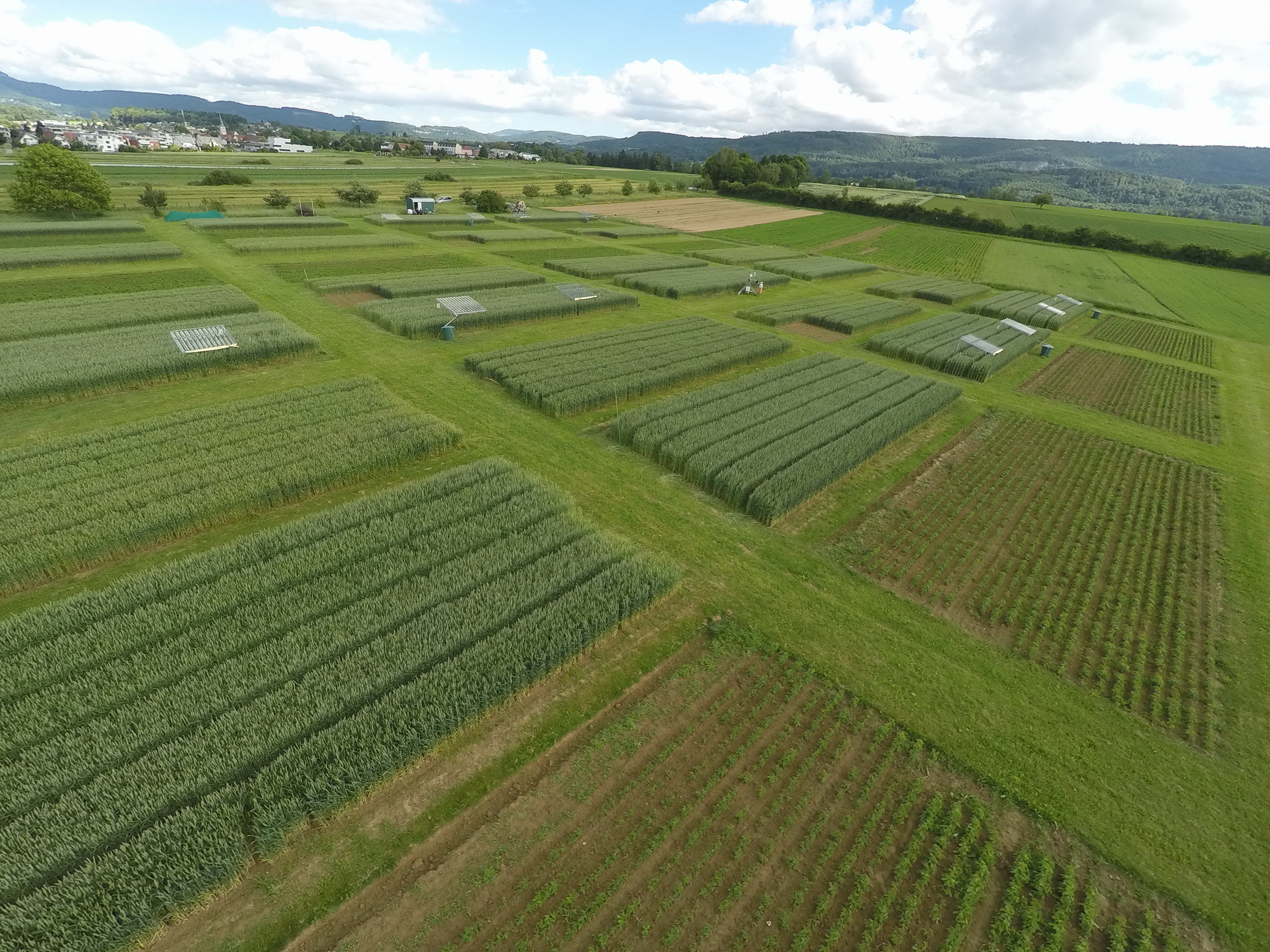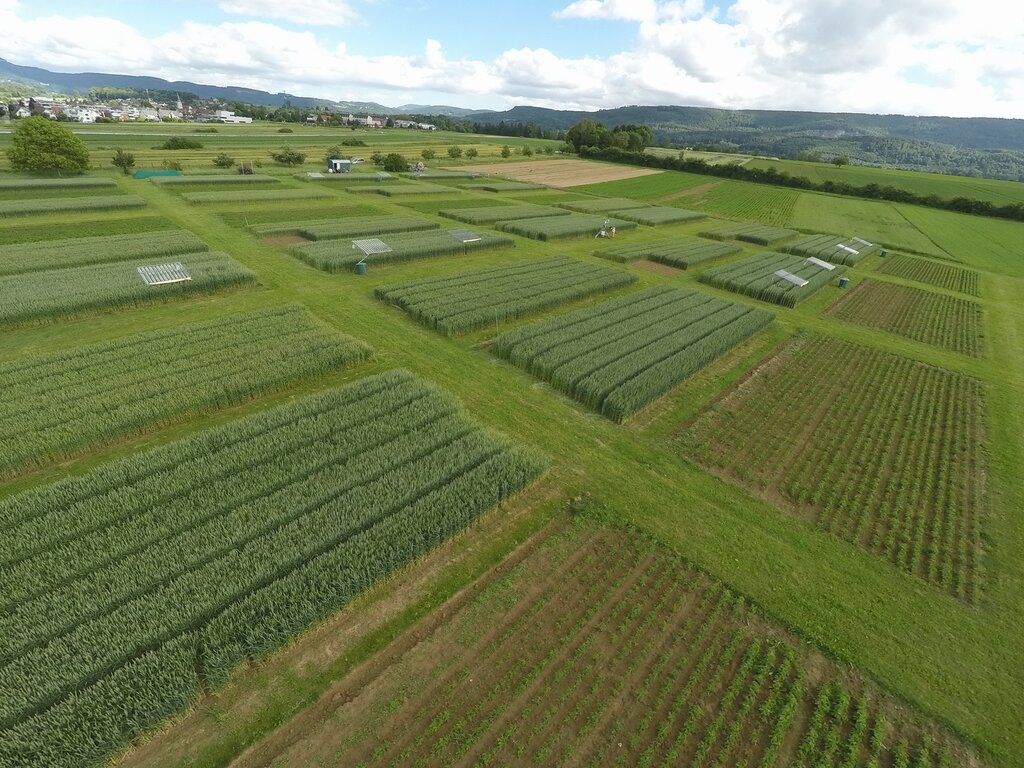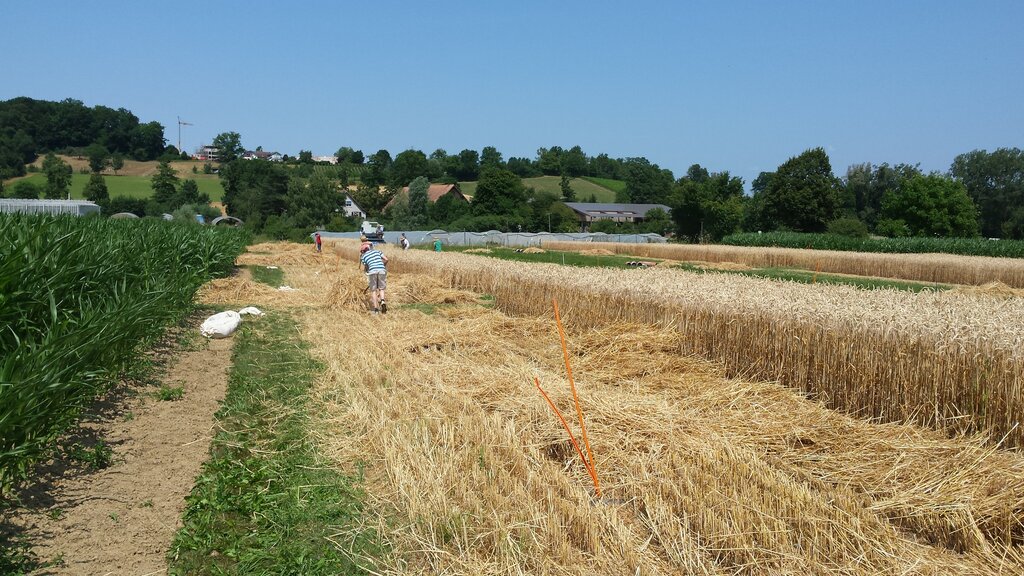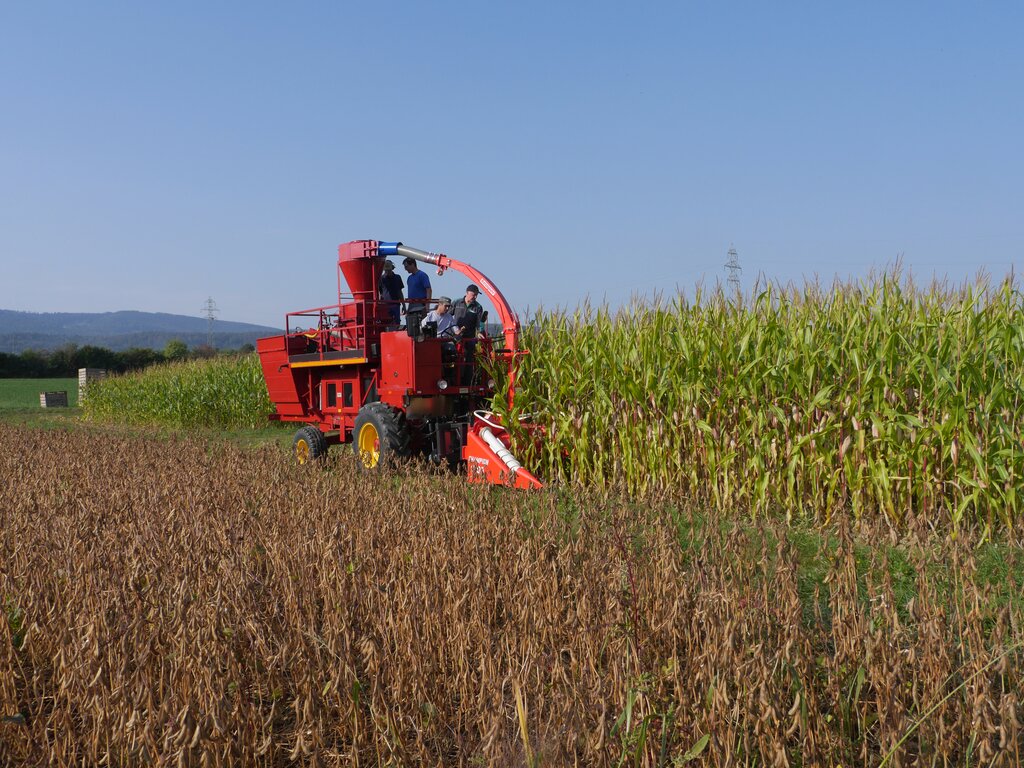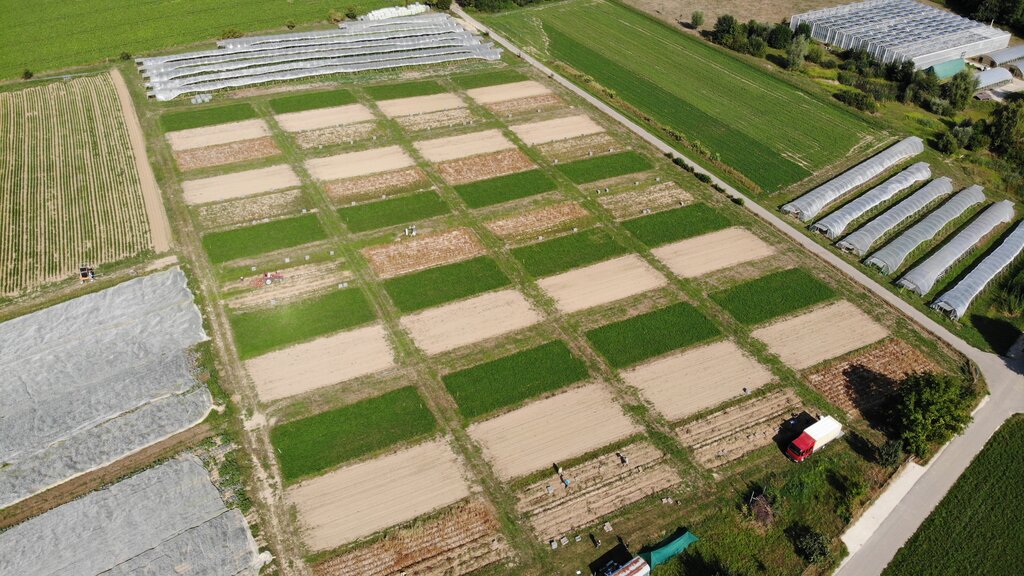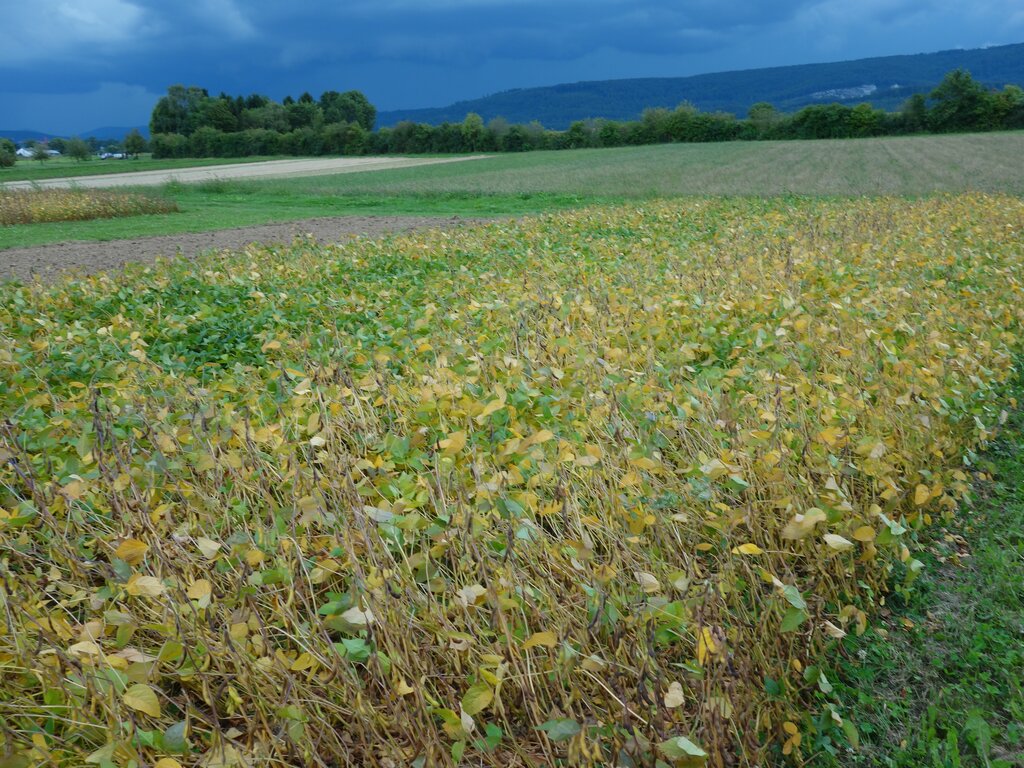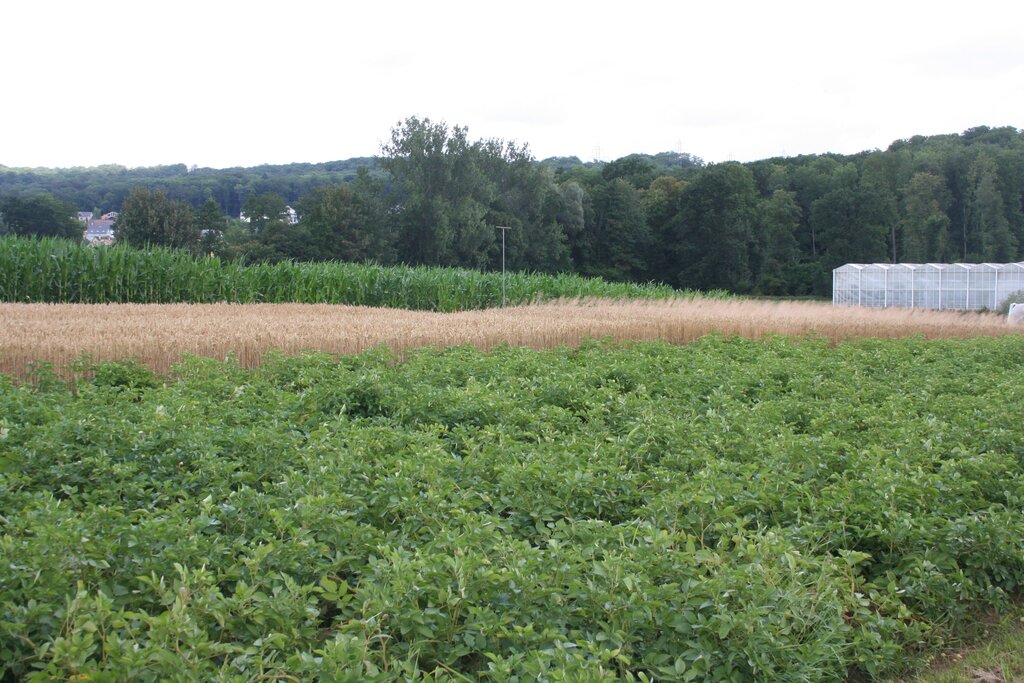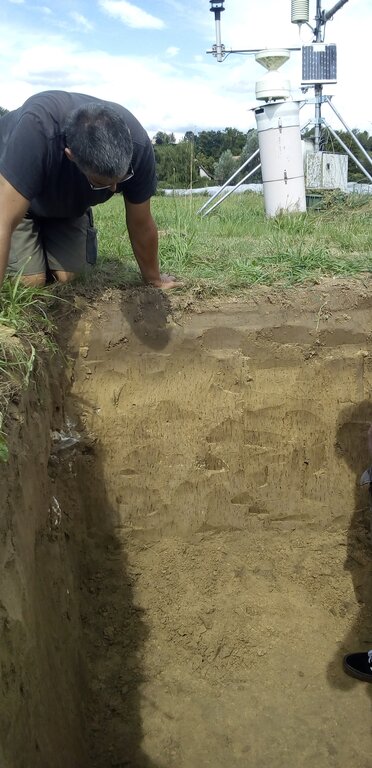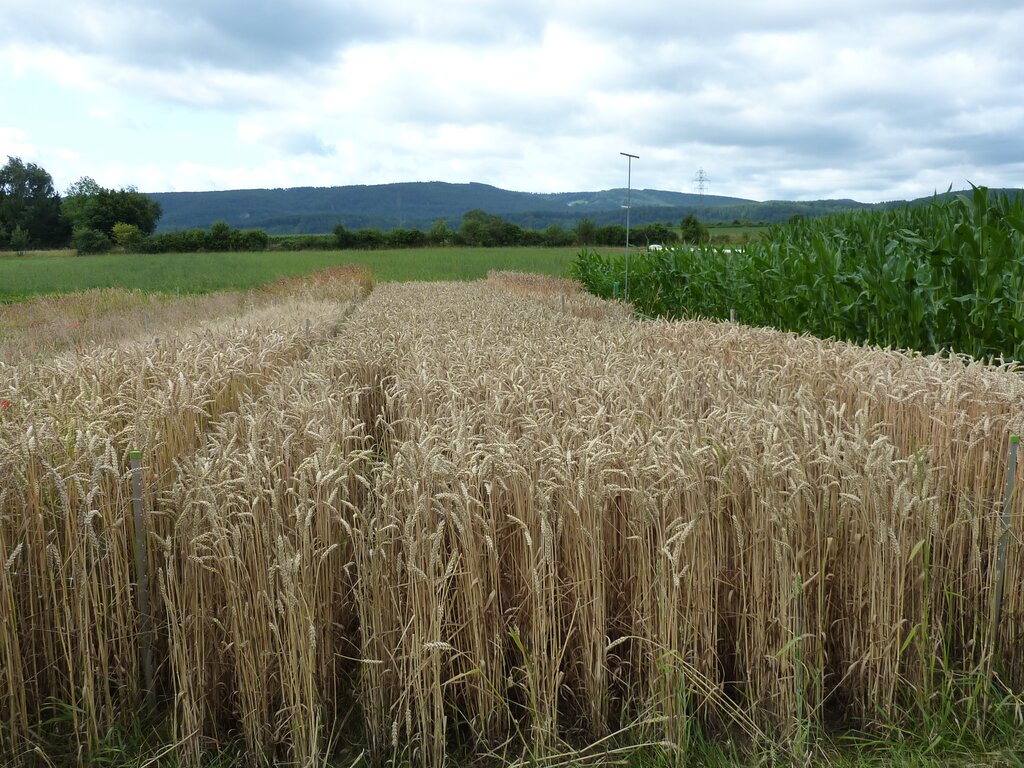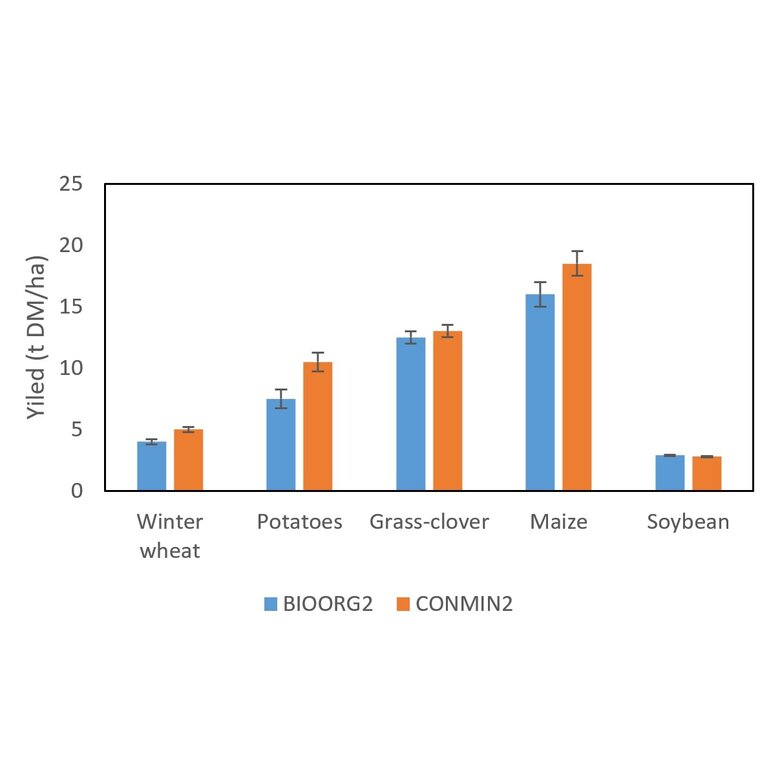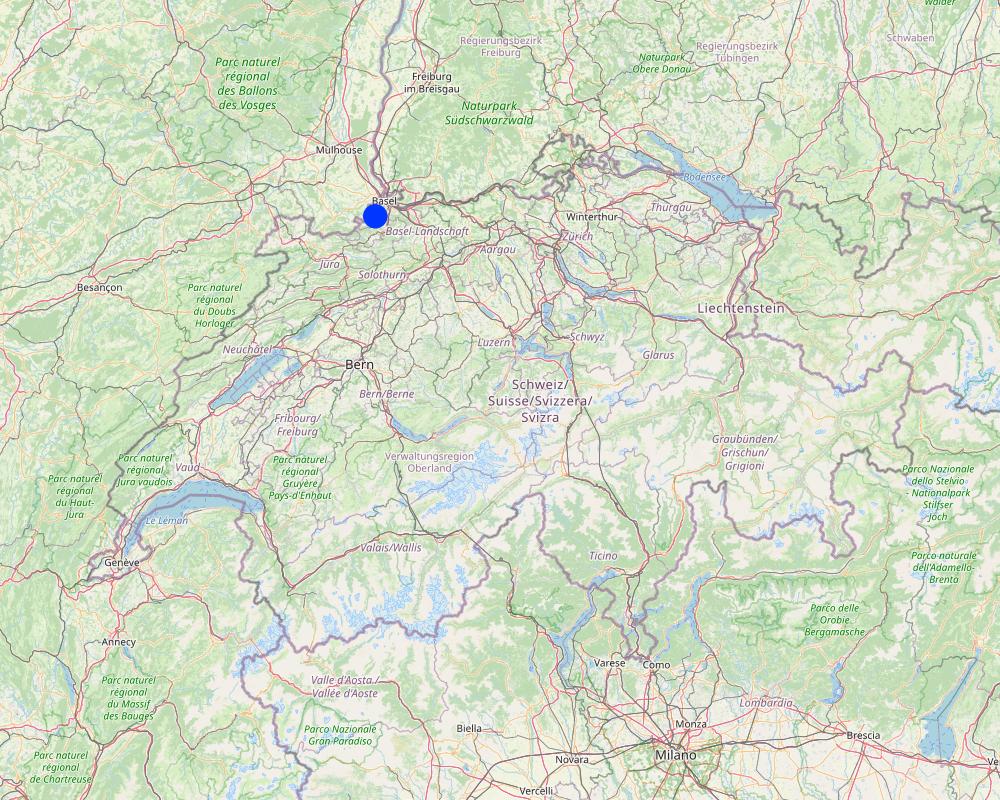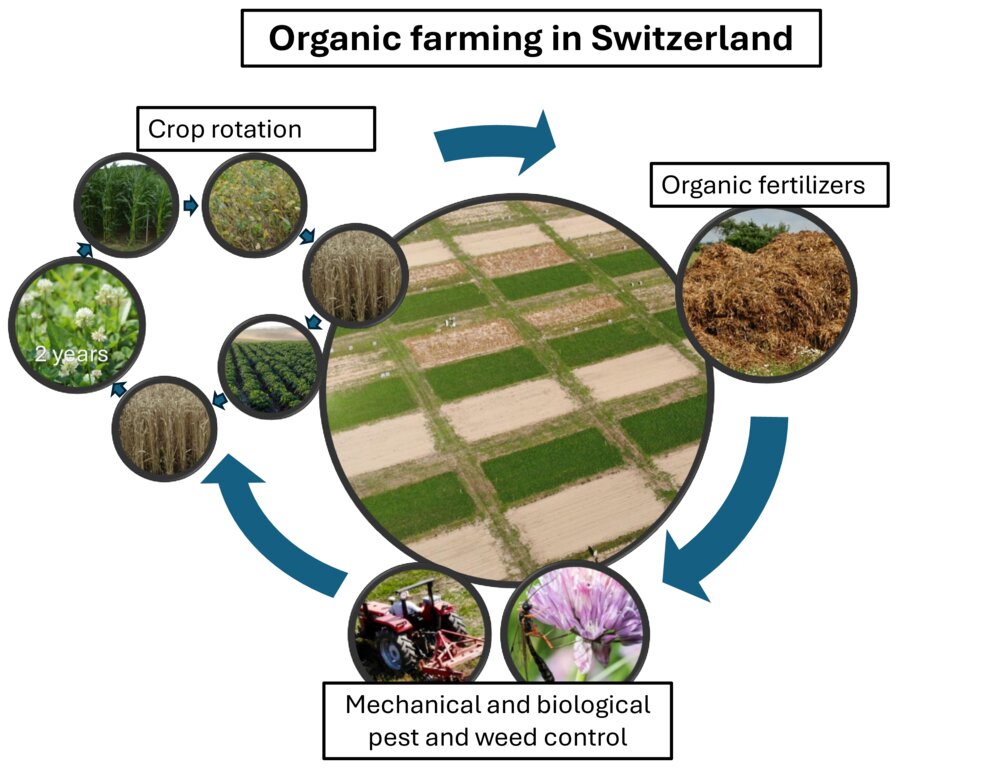Organic Agriculture (DOK Experiment) [瑞士]
- 创建:
- 更新:
- 编制者: Moritz Laub
- 编辑者: Jochen Mayer, Hans-Martin Krause
- 审查者: Rima Mekdaschi Studer, William Critchley
Biologischer Landbau/ Biologische Landwirtschaft
technologies_7138 - 瑞士
查看章节
全部展开 全部收起1. 一般信息
1.2 参与该技术评估和文件编制的资源人员和机构的联系方式
SLM专业人员:
有助于对技术进行记录/评估的项目名称(如相关)
Land Use Based Mitigation for Resilient Climate Pathways (LANDMARC)有助于对技术进行记录/评估的机构名称(如相关)
Research institut for organic agriculture (FiBL) - 瑞士有助于对技术进行记录/评估的机构名称(如相关)
Forschungsanstalt Agroscope Reckenholz-Tänikon ART (Forschungsanstalt Agroscope Reckenholz-Tänikon ART) - 瑞士有助于对技术进行记录/评估的机构名称(如相关)
ETH-Zürich (ETH-Zürich) - 瑞士1.3 关于使用通过WOCAT记录的数据的条件
编制者和关键资源人员接受有关使用通过WOCAT记录数据的条件。:
是
1.4 所述技术的可持续性声明
这里所描述的技术在土地退化方面是否存在问题,导致无法被认为是一种可持续的土地管理技术?:
否
2. SLM技术的说明
2.1 技术简介
技术定义:
Organic agriculture is a system of crop cultivation that uses biological methods of pest control and organic fertilizer as substitutes for chemical fertilizers and pesticides. It targets sustainability, enhancement of soil fertility, and biological diversity by aiming to close nutrient cycles while generally prohibiting synthetic pesticides, antibiotics, synthetic fertilizers, genetically modified organisms, and growth hormones.
2.2 技术的详细说明
说明:
Organic agriculture is a globally applied technology practiced on agricultural land. It is carried out in 188 countries, with over 96 million hectares of agricultural land managed organically by at least 4.5 million farmers.
The main elements of this technology include the use of biological methods of pest control and organic fertilizer application, which replace chemical fertilizers and pesticides. It generally prohibits synthetic pesticides, antibiotics, synthetic fertilizers, genetically modified organisms, and growth hormones. The purpose of organic agriculture is to achieve sustainability in farming, enhancing soil fertility, increasing biological diversity and reducing the reliance on external inputs to agriculture, relying on nutrient recycling by applying manure and on biological nitrogen fixation from legumes. It also aims to provide a healthier and more environmentally friendly alternative to conventional farming practices. To establish and maintain organic agriculture, major activities include the application of organic fertilizers, crop rotation, and the use of pest-resistant plant varieties. Regular soil testing and monitoring of pest populations are also necessary. Certification of a farm as being officially organic is needed if the products are to be sold at a price premium.
Organic agriculture can improve soil health, reduce pollution of the surrounding environment, and contribute to biodiversity in the fields. Moreover, it can offer healthier food options and potentially higher income for farmers due to the premium prices of organic products. Land users appreciate organic agriculture for its environmental benefits and potential for higher income. However, some dislike the increased labour and time required, the 10-30% of reduction in yields, compared to conventional agriculture, as well as the need for a transition period before farms can be certified as organic and products sold at a premium price.
The DOK experiment presented here is representative of organic practices in the context of temperate regions (specifically, Switzerland and surrounding countries). It is jointly managed by the Research Institute of Organic Agriculture (FiBL), and by the Swiss Confederation's centre of excellence for agricultural research (Agroscope). The name "DOK Experiment" is derived from its main purpose, to compare three cultivation systems: Biodynamic (D), organic (O) and conventional (K) agriculture. These differ in terms of how they are fertilized (D: liquid manure, manure compost, biodynamic preparations; O: liquid manure, rotted manure; K: two variants, one with liquid manure, fresh or rotted manure, mineral fertilizer (CONFYM variant) and one with only mineral fertilizer (CONMIN variant)), as well as by plant protection (D and O: organic; K: chemical-synthetic). In addition to two fertilization levels of the three cultivation systems (half fertilization and standard practice fertilization), two controls are carried out, an unfertilized (N) and a purely mineral-fertilized variant (M). The experiment is spatially replicated four times. The results presented here refer to the conventional (K) and the organic (O) treatments at the standard practice fertilization level.
2.3 技术照片
2.4 技术视频
注释、简短说明:
DOK-Versuch: Biologische und konventionelle Landwirtschaft im Langzeitvergleich
https://www.youtube.com/watch?v=gDCLHxU0ijg
日期:
16/07/2014
位置:
Therwil
注释、简短说明:
Der DOK-Versuch - Eine Internationale Forschungsplattform (Juni 2015)
https://www.youtube.com/watch?v=QYBS4Qj7T14
日期:
16/06/2015
位置:
Therwil
2.5 已应用该技术的、本评估所涵盖的国家/地区/地点
国家:
瑞士
区域/州/省:
Basel
有关地点的进一步说明:
Therwil
具体说明该技术的分布:
- 适用于特定场所/集中在较小区域
技术现场是否位于永久保护区?:
否
Map
×2.6 实施日期
注明实施年份:
1978
2.7 技术介绍
详细说明该技术是如何引入的:
- 在实验/研究期间
注释(项目类型等):
This is a research site, investigating the benefits of organic agriculture.
3. SLM技术的分类
3.1 该技术的主要目的
- 减少、预防、恢复土地退化
- 保护生态系统
- 保持/提高生物多样性
- 创造有益的社会影响
3.2 应用该技术的当前土地利用类型
同一土地单元内混合使用的土地::
否

农田
- 一年一作
年作 - 具体指明作物:
- 谷物类 - 玉米
- 谷类 - 小麦(冬季)
- 饲料作物 - 三叶草
- 豆科牧草和豆类 - 大豆
- 根/块茎作物 - 土豆
年作制度:
小麦或类似的干草/牧场轮作
每年的生长季节数:
- 1
采用轮作制度了吗?:
是
如果是,请具体说明:
The typical crop rotation over the last three cycles was: silage maize, soybean, winter wheat, potato, winter wheat, and two years of grass-clover (Knapp et al. 2023).
3.3 由于技术的实施,土地使用是否发生了变化?
由于技术的实施,土地使用是否发生了变化?:
- 否(继续问题3.4)
3.4 供水
该技术所应用土地的供水:
- 雨养
3.5 该技术所属的SLM组
- 轮作制度(轮作、休耕、轮垦)
- 农畜综合管理
- 病虫害综合管理(包括有机农业)
3.6 包含该技术的可持续土地管理措施

农艺措施
- A2:有机质/土壤肥力
- A5:种子管理,改良品种
- A6:残株管理
A6:对残株管理作出具体说明:
A 6.4:保留
注释:
Comment to A5: It is aimed to use pest-resistant crop varieties, because chemical pesticides are not allowed in organic agriculture.
3.7 该技术强调的主要土地退化类型

化学性土壤退化
- Cn:肥力下降和有机质含量下降(非侵蚀所致)

生物性退化
- Bs:质量和物种组成/多样性的下降
- Bl:土壤寿命损失
3.8 防止、减少或恢复土地退化
具体数量名该技术与土地退化有关的目标:
- 防止土地退化
- 减少土地退化
4. 技术规范、实施活动、投入和成本
4.1 该技术的技术图纸
技术规范(与技术图纸相关):
A summary of the principles of organic farming in Switzerland
作者:
Moritz Laub
日期:
26/06/2024
4.2 有关投入和成本计算的一般信息
具体说明成本和投入是如何计算的:
- 每个技术区域
注明尺寸和面积单位:
ha
如果使用本地面积单位,注明转换系数为1公顷(例如1公顷=2.47英亩):1公顷=:
1 ha
其它/国家货币(具体说明):
CHF
如相关,注明美元与当地货币的汇率(例如1美元=79.9巴西雷亚尔):1美元=:
0.91
注明雇用劳工的每日平均工资成本:
160-240
4.3 技术建立活动
| 活动 | 时间(季度) | |
|---|---|---|
| 1. | Courses on the principles of organic farming | Before transition |
| 2. | Transitioning period (already practicing but not yet certified) | 2 years |
| 3. | Certification | Start of year 3 |
注释:
Detailed information on the transition process and requirements can be found here:
https://www.fibl.org/de/shop/1001-umstellung
4.4 技术建立所需要的费用和投入
注释:
Courses are needed when transitioning to organic agriculture. They usually take around a week and the cost of courses depends locally.
Further, there are costs for certification, which are usually 400 CHF.
The main costs of transitioning is lost yields in the years during transition, when there is no price premium, yet. Subsidies depend on the Swiss Canton.
Some detailed information on the cost associated with transition can be found here:
https://www.bioaktuell.ch/grundlagen/umstellung/allgemein/kosten-und-beitraege
4.5 维护/经常性活动
| 活动 | 时间/频率 | |
|---|---|---|
| 1. | Application of manure | At least yearly |
| 2. | Application of slurry | Usually twice a year |
| 3. | Soil preparation by harrow or cultivator | Yearly |
| 4. | Weed supression by tine weeder | At least yearly |
| 5. | Biological pesticide application (e.g., Novodor) | When needed, mostly in potato |
| 6. | Planting of cover crop | After wheat |
| 7. | Mulching cover crop | Before planting soy/maize |
注释:
The measures here reflect the activities that are in addition to conventional management needs. Their exact sequence depends on selected crop rotation. In the DOK experiment is was silage maize, soybean, winter wheat, potato, winter wheat, and two years of grass-clover.
4.6 维护/经常性活动所需要的费用和投入(每年)
| 对投入进行具体说明 | 单位 | 数量 | 单位成本 | 每项投入的总成本 | 土地使用者承担的成本% | |
|---|---|---|---|---|---|---|
| 劳动力 | Labour requirements compared to conventional agriculture | % | 113.0 |
注释:
Because this is a research trial, the detailed costs are neither available nor would they be representative of typical organic farms. Therefore, it is best to rely on the estimated costs from an international study. Based on this study there are 13% higher labour costs in organic farming, but the higher labor cost in organic systems is offset by lower costs of purchased inputs. The total production cost is not different to conventional farming. When the actual organic premiums are considered, gross returns, benefit/cost ratios, and net present values are significantly higher for organic crops compared to conventional crops (21%, 24%, and 35%, respectively).
The study is available here:
https://www.doi.org/10.1073/pnas.1423674112
A good way to estimate the costs of organic vs conventional production is the KTBL Performance Cost calulator. It can be specified to farm and machinery size, soil type and has an option for organic agriculture to see the differences. (only in German language):
https://daten.ktbl.de/dslkrpflanze/postHv.html
4.7 影响成本的最重要因素
描述影响成本的最决定性因素:
Reduced yield without price premium during transition period.
5. 自然和人文环境
5.1 气候
年降雨量
- < 250毫米
- 251-500毫米
- 501-750毫米
- 751-1,000毫米
- 1,001-1,500毫米
- 1,501-2,000毫米
- 2,001-3,000毫米
- 3,001-4,000毫米
- > 4,000毫米
指定年平均降雨量(若已知),单位为mm:
840.00
有关降雨的规范/注释:
Typical temperate climate. Rainfall is mostly evenly distributed throughout the year with slightly higher values in May, June, July and August.
农业气候带
- 潮湿的
5.2 地形
平均坡度:
- 水平(0-2%)
- 缓降(3-5%)
- 平缓(6-10%)
- 滚坡(11-15%)
- 崎岖(16-30%)
- 陡峭(31-60%)
- 非常陡峭(>60%)
地形:
- 高原/平原
- 山脊
- 山坡
- 山地斜坡
- 麓坡
- 谷底
垂直分布带:
- 0-100 m a.s.l.
- 101-500 m a.s.l.
- 501-1,000 m a.s.l.
- 1,001-1,500 m a.s.l.
- 1,501-2,000 m a.s.l.
- 2,001-2,500 m a.s.l.
- 2,501-3,000 m a.s.l.
- 3,001-4,000 m a.s.l.
- > 4,000 m a.s.l.
说明该技术是否专门应用于:
- 不相关
5.3 土壤
平均土层深度:
- 非常浅(0-20厘米)
- 浅(21-50厘米)
- 中等深度(51-80厘米)
- 深(81-120厘米)
- 非常深(> 120厘米)
土壤质地(表土):
- 中粒(壤土、粉土)
土壤质地(地表以下> 20厘米):
- 中粒(壤土、粉土)
表土有机质:
- 中(1-3%)
5.4 水资源可用性和质量
地下水位表:
5-50米
地表水的可用性:
好
水质(未处理):
良好饮用水
水质请参考::
地下水
水的盐度有问题吗?:
否
该区域正在发生洪水吗?:
否
5.5 生物多样性
物种多样性:
- 中等
栖息地多样性:
- 中等
5.6 应用该技术的土地使用者的特征
定栖或游牧:
- 定栖的
生产系统的市场定位:
- 商业/市场
非农收入:
- 收入的10-50%
相对财富水平:
- 平均水平
个人或集体:
- 个人/家庭
机械化水平:
- 机械化/电动
性别:
- 女人
- 男人
土地使用者的年龄:
- 中年人
5.7 应用该技术的土地使用者使用的平均土地面积
- < 0.5 公顷
- 0.5-1 公顷
- 1-2 公顷
- 2-5公顷
- 5-15公顷
- 15-50公顷
- 50-100公顷
- 100-500公顷
- 500-1,000公顷
- 1,000-10,000公顷
- > 10,000公顷
这被认为是小规模、中规模还是大规模的(参照当地实际情况)?:
- 中等规模的
注释:
Area refers to typical users (not the DOK Experiment)
5.8 土地所有权、土地使用权和水使用权
土地所有权:
- 个人,有命名
土地使用权:
- 租赁
- 个人
- irrigation not common
土地使用权是否基于传统的法律制度?:
否
5.9 进入服务和基础设施的通道
健康:
- 贫瘠
- 适度的
- 好
教育:
- 贫瘠
- 适度的
- 好
技术援助:
- 贫瘠
- 适度的
- 好
就业(例如非农):
- 贫瘠
- 适度的
- 好
市场:
- 贫瘠
- 适度的
- 好
能源:
- 贫瘠
- 适度的
- 好
道路和交通:
- 贫瘠
- 适度的
- 好
饮用水和卫生设施:
- 贫瘠
- 适度的
- 好
金融服务:
- 贫瘠
- 适度的
- 好
6. 影响和结论性说明
6.1 该技术的现场影响
社会经济效应
生产
作物生产
SLM之前的数量:
Mean wheat yield of 5 t DM/ha
SLM之后的数量:
Mean wheat yield of 4 t DM/ha
注释/具体说明:
Other mean yields of organic treatment (BIOORG2 with 1.4 livestock units):
Potatoes: 7.5 t DM/ha
Soybean: 2.8 t DM/ha
Other mean yields of conventional treatment with only mineral fertilizer(CONMIN2):
Potatoes: 10 t DM/ha
Soybean: 2.8 t DM/ha
饲料生产
SLM之前的数量:
Grass-clover: 13 t DM/ha
SLM之后的数量:
Grass-clover: 12.5 t DM/ha
注释/具体说明:
Other mean yields of organic treatment (BIOORG2 with 1.4 livestock units):
Maize silage: 17 t DM/ha
Other mean yields of conventional treatment with only mineral fertilizer(CONMIN2):
Maize silage: 19 t DM/ha
收入和成本
农业投入费用
注释/具体说明:
Refers to overall organic agriculture in Switzerland (not DOK experiment)
农业收入
注释/具体说明:
Refers to overall organic agriculture in Switzerland (not DOK experiment)
收入来源的多样性
注释/具体说明:
Refers to overall organic agriculture in Switzerland (not DOK experiment)
工作量
注释/具体说明:
Refers to overall organic agriculture in Switzerland (not DOK experiment)
生态影响
土壤
土壤有机物/地下C
SLM之前的数量:
About 1.3% SOC in the mineral fertilizer treatment in 2020
SLM之后的数量:
About 1.6% SOC in the organic agriculture treatment in 2020
注释/具体说明:
Organic treatment refers to BIOORG2 with 1.4 livestock units. Conventional treatment to the one with only mineral fertilizer (CONMIN2).
酸度
SLM之前的数量:
pH of 6.3 in the mineral fertilizer treatment in 2020
SLM之后的数量:
pH of 6.5 in the organic agriculture treatment in 2020
注释/具体说明:
Organic treatment refers to BIOORG2 with 1.4 livestock units. Conventional treatment to the one with only mineral fertilizer (CONMIN2).
对现场影响的评估(测量)进行具体说明:
All presented results are from published studies about the DOK experiment.
6.2 该技术的场外影响已经显现
地下水/河流污染
Greenhouse gas emissions per land area
注释/具体说明:
Based on a recent modeling study, emissions were between 0.5 to 1 t CO2 equivalent less per ha and year in organic compared to conventional agriculture in Switzerland (https://doi.org/10.1016/j.agsy.2020.102822).
Greenhouse gas emissions per calorie
注释/具体说明:
In contrast to emissions per land area, it has been found that due to the lower yields there is little difference in terms of emissions per unit of food produced (https://doi.org/10.1088/1748-9326/aa6cd5).
对场外影响(测量)的评估进行具体说明:
There are ongoing debates on whether organic agriculture really leads to lower emissions than conventional agriculture, and the conclusion largely depends on the unit of reference (amount of food vs. per ha).
6.3 技术对渐变气候以及与气候相关的极端情况/灾害的暴露和敏感性(土地使用者认为的极端情况/灾害)
渐变气候
渐变气候
| 季节 | 增加或减少 | 该技术是如何应对的? | |
|---|---|---|---|
| 年温度 | 增加 | 好 | |
| 季雨量 | 夏季 | 减少 | 好 |
气候有关的极端情况(灾害)
气候灾害
| 该技术是如何应对的? | |
|---|---|
| 干旱 | 适度 |
注释:
Preliminary results from rain-emission shelters indicates similar resilience of the organic agriculture treatment as the conventional ones to drought.
However, organic agriculture in general is expected to better cope with climate change than conventional agriculture (https://www.fibl.org/fileadmin/documents/shop/1500-climate-change.pdf)
6.4 成本效益分析
技术收益与技术建立成本相比如何(从土地使用者的角度看)?
短期回报:
消极
长期回报:
积极
技术收益与技术维护成本/经常性成本相比如何(从土地使用者的角度看)?
短期回报:
稍微积极
长期回报:
稍微积极
注释:
The main establishment costs is that in the first years of establishment, farmers have to apply all organic principles and thus have lower yields. However, certification as organic produce, which receive price premiums, is only possible 1-3 years after establishment, depending on the farm type. Thus, there is a period in which the lower yields are not yet compensated by a price premium. Once the system is certified and a price premium received, gross returns, benefit/cost ratios, and net present values are significantly higher for organic crops compared to conventional crops (https://www.doi.org/10.1073/pnas.1423674112)
6.5 技术采用
- 11-50%
如若可行,进行量化(住户数量和/或覆盖面积):
About 16% of all farms in Switzerland are currently organic. (BAFU; https://www.bfs.admin.ch/news/de/2024-0392)
在所有采用这项技术的人当中,有多少人是自发的,即未获得任何物质奖励/付款?:
- 51-90%
注释:
Switzerland has specific subsidies for those that practice organic farming but also many subsidies that all farmers receive. It is thus not 100% clear how many farmers were mainly incentivized by the additional subsidies. However, most become organic farmers out of conviction that it is the better and more sustainable farming system.
6.6 适应
最近是否对该技术进行了修改以适应不断变化的条件?:
否
6.7 该技术的优点/长处/机会
| 土地使用者眼中的长处/优势/机会 |
|---|
| Higher income due to price premiums |
| Less dependance on external inputs |
| 编制者或其他关键资源人员认为的长处/优势/机会 |
|---|
| Better nutrient cycling and soil fertility. |
6.8 技术的弱点/缺点/风险及其克服方法
| 编制者或其他关键资源人员认为的弱点/缺点/风险 | 如何克服它们? |
|---|---|
| Lower yields compared to conventional agriculture. | Price premium. Eating less meat, which consumes most of the agricultural produce. |
7. 参考和链接
7.1 信息的方法/来源
- 与SLM专业人员/专家的访谈
6
- 根据报告和其他现有文档进行编译
(现场)数据是什么时候汇编的?:
27/02/2019
注释:
Date of most recent soil sampling
7.2 参考可用出版物
标题、作者、年份、ISBN:
Knapp, S., Gunst, L., Mäder, P., Ghiasi, S., Mayer, J., 2023. Organic cropping systems maintain yields but have lower yield levels and yield stability than conventional systems – Results from the DOK trial in Switzerland. Field Crops Research 302, 109072.
可以从哪里获得?成本如何?
For free: https://doi.org/10.1016/j.fcr.2023.109072
标题、作者、年份、ISBN:
Krause, H.-M., Stehle, B., Mayer, J., Mayer, M., Steffens, M., Mäder, P., Fliessbach, A., 2022. Biological soil quality and soil organic carbon change in biodynamic, organic, and conventional farming systems after 42 years. Agron. Sustain. Dev. 42, 117.
可以从哪里获得?成本如何?
For free: https://doi.org/10.1007/s13593-022-00843-y
标题、作者、年份、ISBN:
Mayer, M., Krause, H.-M., Fliessbach, A., Mäder, P., Steffens, M., 2022. Fertilizer quality and labile soil organic matter fractions are vital for organic carbon sequestration in temperate arable soils within a long-term trial in Switzerland. Geoderma 426, 116080.
可以从哪里获得?成本如何?
For free: https://doi.org/10.1016/j.geoderma.2022.116080
标题、作者、年份、ISBN:
Crowder, D.W., Reganold, J.P., 2015. Financial competitiveness of organic agriculture on a global scale. Proceedings of the National Academy of Sciences 112, 7611–7616.
可以从哪里获得?成本如何?
For free: https://doi.org/10.1073/pnas.1423674112
7.3 链接到网络上的相关信息
标题/说明:
FIBL Webpage DOK trials
URL:
https://www.fibl.org/en/themes/projectdatabase/projectitem/project/404
7.4 一般注释
Costs are the most difficult to estimate from agricultural experiments (not real field conditions)
链接和模块
全部展开 全部收起链接
无链接
模块
无模块


